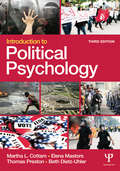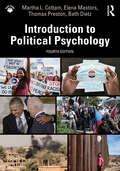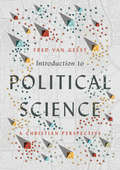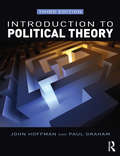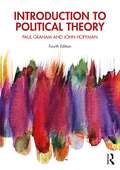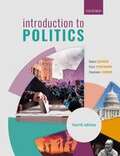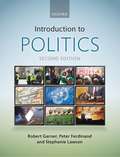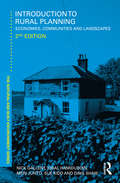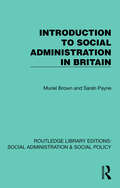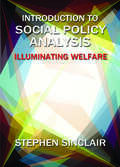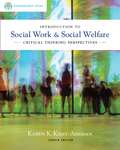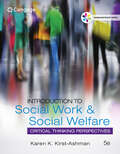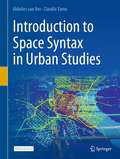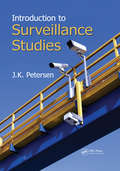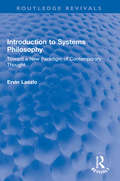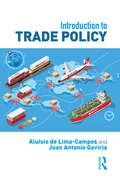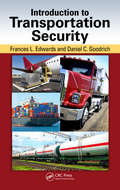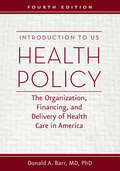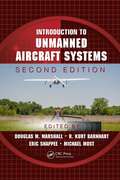- Table View
- List View
Introduction to Political Psychology: 3rd Edition
by Thomas Preston Beth Dietz Martha L. Cottam Elena MastorsThis comprehensive, user-friendly introductory textbook to political psychology explores the psychological origins of political behavior. The authors introduce readers to a broad range of theories, concepts, and case studies of political activity to illustrate that behavior. The book examines many patterns of political behaviors, including leadership, group behavior, voting, media effects, race, ethnicity, nationalism, social movements, terrorism, war, and genocide. It explores some of the most horrific things people do to each other, as well as how to prevent and resolve conflict - and how to recover from it. The book contains numerous features to enhance understanding, including text boxes highlighting current and historical events to help students see the connection between the world around them and the concepts they are learning. Different research methodologies used in the discipline are employed, such as experimentation and content analysis. The third edition of the book has two new chapters, one on the media, and one on social movements. This accessible and engaging introductory textbook is suitable as a primary text on a range of upper-level courses in political psychology, political behavior, and related fields, including policymaking.
Introduction to Political Psychology: 3rd Edition
by Thomas Preston Beth Dietz Martha L. Cottam Elena MastorsIntroduction to Political Psychology explores the many psychological patterns that influence individual political behavior. The authors introduce readers to a broad range of theories, concepts, and case studies of political activity, arguing that individuals are driven or motivated to act in accordance with personality characteristics, values, beliefs, and attachments to groups. The book explains many aspects of political behavior—whether seemingly pathological actions or normal decision-making practices, which sometimes work optimally, and sometimes fail. Thoroughly updated throughout, the book examines patterns of political behavior in areas including leadership, group behavior, voting, race, nationalism, terrorism, and war. This edition features coverage of the 2016 election and profiles former U.S. President Donald Trump, while also including updated data on race relations and extremist groups in the United States. Global issues are also considered, with case studies focused on Myanmar and Syria, alongside coverage of social issues including Black Lives Matter and the #MeToo movement. Accessibly written and comprehensive in scope, it is an essential companion for all graduate and upper-level undergraduate students of psychology, political science, and political psychology. It will also be of interest to those in the policy-making community, especially those looking to learn more about the extent to which perceptions, personality, and group dynamics affect the policy-making arena. It is accompanied by a set of online instructor resources.
Introduction to Political Science-1 First Semester FYBA New NEP Syllabus - SPPU
by Dr Pramod R. Tambe Onkar A. KorwaleThe book “Introduction to Political Science-1” by Dr. Pramod R. Tambe and Onkar A. Korwale is a comprehensive introductory text for F.Y.B.A. students, aligning with the 2024 NEP syllabus. It explores the fundamental concepts of political science, including its meaning, nature, scope, and importance, alongside traditional and modern approaches to its study. Key topics include the concept and evolution of the state, its elements, and theories of state formation, such as the divine, social contract, Marxist, and patriarchal theories. Combining philosophical, historical, and empirical perspectives, the book provides a solid foundation for understanding governance, political institutions, and the dynamics of power in society, catering to the academic needs of students and educators.
Introduction to Political Science: A Christian Perspective
by Fred Van GeestIntroduction to Political Science: A Christian Perspective IVP Instructor Resources forthcoming.
Introduction to Political Theory
by Paul Graham John HoffmanIntroduction to Political Theory is a text for the 21st century. It shows students why an understanding of theory is crucial to an understanding of issues and events in a rapidly shifting global political landscape. Bringing together classic and contemporary political concepts and ideologies into one book, this new text introduces the major approaches to political issues that have shaped the modern world, and the ideas that form the currency of political debate. Introduction to Political Theory relates political ideas to political realities through effective use of examples and case studies making theory lively, contentious and relevant. This updated third edition comes with significant revisions which reflect the latest questions facing political theory, such as the French burqa controversy, ethnic nationalism and the value of research from sociobiology. Accompanying these debates is a wealth of new and thought-provoking case studies for discussion, including (consensual) sadomasochism, affirmative action and same-sex marriage. A new chapter on difference has also been added to complement those on feminism and multiculturalism. The revised glossary, revamped website for further reading and new streamlined layout make Introduction to Political Theory third edition the perfect accompaniment to undergraduate study.
Introduction to Political Theory
by Paul Graham John HoffmanThis vibrant and significantly revised new edition is a comprehensive and accessible text for studying political theory in a changing world. Bringing together classic and contemporary political concepts and ideologies into one book, it introduces the major approaches to political issues that have shaped our world, and the ideas that form the currency of political debate. Consistently, it relates political ideas to political realities through effective use of examples and case studies making theory lively, contentious, and relevant. With significant revisions which reflect the latest questions facing political theory in an increasingly international context, key features and updates include: Two brand new chapters on Migration and Freedom of Speech and a significant new section on the radical right; Thought-provoking case studies to bring the theory to life including social media and internet regulation, Brexit and the EU, anti-vaxxer campaigns, surrogacy tourism, and autonomous anarchist zones; A revamped website, including podcasts, to aid study of, and reading around, the subject. Introduction to Political Theory, Fourth Edition is the perfect accompaniment to undergraduate study in political theory, political philosophy, concepts and ideologies, and more broadly to the social sciences and philosophy.
Introduction to Politics
by Robert Garner Peter Ferdinand Stephanie LawsonCombining theory, comparative politics and international relations, Introduction to Politics, Fourth Edition, provides the most comprehensive introduction to the subject for first year undergraduate students, with the most global perspective. <p><p> Written by three experts in the field, this book takes a balanced approach to the subject, serving as a strong foundation for further study. Assuming no prior knowledge, the authors use an accessible yet analytical approach which encourages critical analysis and debate, helping students to develop the vital skills they need for future studies and employment. <p><p> The new edition has been fully updated with additional case studies and examples to help students to understand how key theories and principles apply in the context of real-world events. New to the fourth edition is a chapter on 'Non-Western Approaches', which helps students to bring more diverse perspectives to their study of politics. Furthermore, additional coverage of populism has been included, to reflect current events and developments in discourse. <p><p> This ensures that Introduction to Politics, Fourth Edition is the most contemporary, relevant and essential guide for students new to the study of politics.
Introduction to Politics (Second Edition)
by Robert Garner Peter Ferdinand Stephanie LawsonIntroduction to Politics, Second Edition, provides an intellectually stimulating yet accessible introduction to politics that takes current global realities into account. The text is divided into three sections that reflect the authors' expertise: concepts and ideologies, comparative politics, and international relations.
Introduction to Procurement in the Public Sector (Cornerstones of Public Procurement)
by Theresa R.M. Bauccio-Teschlog Ronald L. King William J. Tommie Jr.Public procurement is an exciting, challenging profession that is responsible for the procurement of goods, services, and construction at every level of government, estimated at nearly 13 trillion US dollars worldwide. Public procurement professionals often work behind the scenes to promote responsive and responsible government, improving the quality of life for the people in their communities. Introduction to Procurement in the Public Sector, Fourth Edition is designed to provide an overview of the field, introduce the reader to the public procurement profession, and explore the wide variety of responsibilities and practices that must be addressed throughout the public procurement cycle.This book offers a thorough and complete overview of the function and profession of public procurement, explores legal frameworks, examines contract administration, and investigates a variety of solicitation methods and processes, with an emphasis on what happens post-award, including surplus and disposal. Introduction to Procurement in the Public Sector, Fourth Edition provides the reader with a comprehensive understanding of the public procurement profession, as well as insight into methods, strategies, and tools for successful and ethical procurement practice. The book is an ideal primer for those entering the field of public procurement and serves as a comprehensive textbook for courses in public administration, supply chain management, and related fields of study.
Introduction to Professional Policing: Examining the Evidence Base
by Ian PepperPolicing is a dynamic profession with increasing demands and complexities placed upon police officers, staff and volunteers who provide a 24-hour service across a diverse range of communities. Written by experts in policing higher education from across both academic and professional practice, this book equips aspiring or newly appointed police officers, staff and volunteers with the knowledge and understanding to deal with the significant and often complex challenges they face daily.This second edition of Introduction to Professional Policing explores a number of the core underpinning knowledge requirements identified as themes within the ever-evolving National Policing Curriculum (NPC) and Police Constable Entry Routes (PCER), while also informing those embarking on leadership development. These include: Community and neighbourhood policing Counter-terrorism Digital policing Ethics, equality, diversity and inclusion Evidence-based policing Maintaining professional standards Police leadership Problem solving and problem-oriented policing Victims and protecting the vulnerable Volunteers in policing This edition has been reviewed and significantly updated in line with the dynamic and ongoing demands faced by operational policing and therefore the associated knowledge requirements for policing education and training. The book is refocused on the learning requirements contained within the range of entry routes now available in to policing, as well as the professional development of those serving as police staff and volunteers. This includes new chapters providing insights into community and neighbourhood policing, problem solving and volunteers in policing.At the end of each chapter the student finds a case study, reflective questions and an extensive reference list, all of which reinforces students’ knowledge and furthers their professional development. Written in a clear and direct style, this book supports aspiring police officers, newly appointed police officers, direct entry detectives, community support officers, special constables and police staff. It will also be of interest to those embarking on a leadership journey within policing and anyone wanting to learn more about the profession of policing. It is essential reading for students taking a professional policing degree or commencing any of the police constable entry routes.
Introduction to Residential Layout
by Mike BiddulphIntroduction to Residential Layout is ideal for students and practitioners of urban design, planning, engineering, architecture and landscape seeking a comprehensive guide to the theory and practice of designing and laying out residential areas.Mike Biddulph provides a clear and coherent framework from which he offers comprehensive practical advice for designers of housing developments. Referring to a wealth of international examples, this is a richly illustrated, accessible resource covering the whole range of issues that should be considered byanyone engaging in the planning and design of a new residential scheme.A successful residential development must work on many levels – financial, social and environmental. This book includes analysis of commercial viability, the importance of place making, environmental sustainability and designing accessibility. Mike Biddulph details successful approaches to designing out crime and maximising permeability as part of an integrated approach to urban design.Highly illustrated throughout, this work will show you how to turn design aspirations and principles into practical design solutions. Written without preconceptions, Introduction to Residential Designhighlights the strengths and weaknesses of particular design solutions to encourage both depth of thought and creativity.Mike Biddulph is Senior Lecturer in Urban Design at Cardiff University
Introduction to Rural Planning: Economies, Communities and Landscapes
by Nick Gallent Iqbal Hamiduddin Meri Juntti Sue Kidd Dave ShawIntroduction to Rural Planning: Economies, Communities and Landscapes provides a critical analysis of the key challenges facing rural places and the ways that public policy and community action shape rural spaces.? The second edition provides an examination of the composite nature of ‘rural planning’, which combines land-use and spatial planning elements with community action, countryside management and the projects and programmes of national and supra-national agencies and organisations. It also offers a broad analysis of entrepreneurial social action as a shaper of rural outcomes, with particular coverage of the localism agenda and Neighbourhood Planning in England. With a focus on accessibility and rural transport provision, this book examines the governance arrangements needed to deliver integrated solutions spanning urban and rural places. Through an examination of the ecosystem approach to environmental planning, it links the procurement of ecosystem services to the global challenges of habitat degradation and loss, climate change and resource scarcity and management. A valuable resource for students of planning, rural development and rural geography, Introduction to Rural Planning aims to make sense of current rural challenges and planning approaches, evaluating the currency of the ‘rural’ label in the context of global urbanisation, arguing that rural spaces are relational spaces characterised by critical production and consumption tensions.?
Introduction to Social Administration in Britain (Routledge Library Editions: Social Administration & Social Policy)
by Sarah Payne Muriel BrownPublished in 1994, as a revised and updated seventh edition, this classic guide to social administration was first published in 1969. The book provides information about social problems and the structure and working of the social services in the late 20th Century. It also identifies the main lines of development in social legislation and clarifies the issues that dominated social policy, many of which are still relevant today. Major changes to provision in social security, health, education, employment and personal social services have been incorporated and the conflicts around these changes explored. The trend towards the privatization of welfare and the centralizing role of the state are discussed in the context of economic change. This text will be of interest to students, lecturers and professionals in the history of social policy, sociology, policy-making.
Introduction to Social Policy Analysis: Illuminating Welfare
by Stephen SinclairIn this distinctive introduction Stephen Sinclair illuminates the subject of Social Policy by showing readers how Social Policy analysts think about welfare issues and policies. From what influences the decision to have children to how everyday terms such as ‘youth crime’ or ‘poverty’ reveal the structural processes shaping society, the book illustrates the insights which Social Policy analysis offers to understanding the social world and its problems. Written by an academic with extensive experience of teaching Social Policy analysis to new audiences, the book provides a stimulating introduction to the study of the factors and polices shaping wellbeing. Each chapter includes boxed summaries, applied examples illustrating key issues, and bullet points clarifying key concepts and theories.
Introduction to Social Work and Social Welfare: Critical Thinking Perspectives
by Karen K. Kirst-AshmanINTRODUCTION TO SOCIAL WORK & SOCIAL WELFARE: CRITICAL THINKING PERSPECTIVES, 3E gives students who are contemplating a career in social work a solid introduction to the profession. Using clear, engaging prose, author Kirst-Ashman presents a balanced, introductory look within a unifying theme of critical thinking that trains students to be more evaluative of key concepts. The topics covered include practice concepts, social welfare policy concepts, history and current state of the profession, the contexts of practice and populations served, and student development.
Introduction to Social Work and Social Welfare: Critical Thinking Perspectives
by Karen K. Kirst-AshmanKaren K. Kirst-Ashman's introductory book enhances the reader's ability to grasp the essence and spirit of generalist social work and the issues in social welfare that social workers address every day. Giving those contemplating a career in social work a solid introduction to the profession, Kirst-Ashman presents a balanced introductory look within a unifying theme of critical thinking that trains readers to be more evaluative of key concepts. The topics covered include practice concepts, social welfare policy concepts, history and current state of the profession, the contexts of practice and populations served, and professional development.
Introduction to Social Work and Social Welfare: Critical Thinking Perspectives (Mindtap Course List)
by Karen K. Kirst-AshmanDesigned to give you a solid introduction to the profession of social work, INTRODUCTION TO SOCIAL WORK AND SOCIAL WELFARE, 5th Edition helps you understand the issues that social workers address every day. Using a clear and engaging writing style, author Karen K. Kirst-Ashman presents a balanced overview within a unifying theme of critical thinking that will train you to use evaluative skills in your coursework and beyond. In addition, you'll study more efficiently and effectively with accompanying digital resources that provide you with opportunities to complete self-assessments as well as pre- and post-tests for each chapter. Thoughtful case studies throughout the text help to prepare you for your career by showing you what social work practice looks like in different contexts and with different populations.
Introduction to Space Syntax in Urban Studies
by Claudia Yamu Akkelies van NesThis open access textbook is a comprehensive introduction to space syntax method and theory for graduate students and researchers. It provides a step-by-step approach for its application in urban planning and design. This textbook aims to increase the accessibility of the space syntax method for the first time to all graduate students and researchers who are dealing with the built environment, such as those in the field of architecture, urban design and planning, urban sociology, urban geography, archaeology, road engineering, and environmental psychology. Taking a didactical approach, the authors have structured each chapter to explain key concepts and show practical examples followed by underlying theory and provided exercises to facilitate learning in each chapter. The textbook gradually eases the reader into the fundamental concepts and leads them towards complex theories and applications. In summary, the general competencies gain after reading this book are:– to understand, explain, and discuss space syntax as a method and theory;– be capable of undertaking various space syntax analyses such as axial analysis, segment analysis, point depth analysis, or visibility analysis;– be able to apply space syntax for urban research and design practice;– be able to interpret and evaluate space syntax analysis results and embed these in a wider context;– be capable of producing new original work using space syntax.This holistic textbook functions as compulsory literature for spatial analysis courses where space syntax is part of the methods taught. Likewise, this space syntax book is useful for graduate students and researchers who want to do self-study. Furthermore, the book provides readers with the fundamental knowledge to understand and critically reflect on existing literature using space syntax.
Introduction to Surveillance Studies
by J.K. PetersenSurveillance is a divisive issue one might say it is inherently controversial. Used by private industry, law enforcement, and for national security, it can be a potent tool for protecting resources and assets. It can also be extremely invasive, calling into question our basic rights to freedom and privacy. Introduction to Surveillance Studies explo
Introduction to Systems Philosophy: Toward a New Paradigm of Contemporary Thought (Routledge Revivals)
by Ervin LaszloFirst Published in 1972, Introduction to Systems Philosophy presents Ervin Laszlo’s first comprehensive volume on the subject. It argues for a systematic and constructive inquiry into natural phenomenon on the assumption of general order in nature. Laszlo says systems philosophy reintegrates the concept of enduring universals with transient processes within a non-bifurcated, hierarchically differentiated realm of invariant systems, as the ultimate actualities of self-structuring nature. He brings themes like the promise of systems philosophy; theory of natural systems; empirical interpretations of physical, biological, and social systems; frameworks for philosophy of mind, philosophy of nature, ontology, epistemology, metaphysics and normative ethics, to showcase the timeliness and necessity of a return from analytic to synthetic philosophy. This book is an essential read for any scholar and researcher of philosophy, philosophy of science and systems theory.
Introduction to Trade Policy
by Aluisio Lima-Campos Juan GaviriaIntroduction to Trade Policy provides a comprehensive overview of the rules and regulations that govern trade flow. It discusses the trade policy formulation process of major international economic players, and analyzes existing trade policy tools that countries may resort to in order to take advantage of the benefits of international trade and to protect themselves against its dangers, as well as their implications for trade policy, law and negotiations. In Section I, the book explores the ways in which interest groups interact with government and legislators to shape trade policies. By developing an analytical view of trade policy formulation systems in the U.S., European Union, the BRICS countries (Brazil, Russia, India, China and South Africa), Canada, Mexico and Australia, the book will help the reader to gain a better understanding of these countries’ trade policy developments and also to apply such learning to the analysis of the trade policy formulation of any other countries. Section II goes on to explain how trade policy tools are used by governments to achieve trade and other policy objectives, while Section III analyses trade in services and the multilateral trade rules on Intellectual Property. Finally, Section IV uses hypothetical case studies in simulation exercises to illustrate trade policy decision-making and trade agreement negotiations in a bilateral, plurilateral and multilateral setting. This is the ideal introduction to international trade policy formulation for students and professionals in the areas of law, politics, economics and public policy who are seeking to develop a global view of international trade, gain insights into trade negotiations and understand the motivations behind the policies and actions of governments regarding international trade issues. This book is also the ideal companion to any traditional legal casebook on international trade or on international economic law.
Introduction to Transportation Security
by Frances L. Edwards Daniel C. GoodrichTransportation is the lifeline of any nation, connecting people, supporting the economy, and facilitating the delivery of vital goods and services. The 9/11 attacks and other attacks on surface transportation assets, including the bombings in Madrid, London, Moscow, and Mumbai demonstrate the vulnerability of the open systems to disruption and the
Introduction to Transportation Security
by Frances L. Edwards Daniel C. GoodrichProviding students and industry managers with the knowledge, skills, and abilities to effectively manage the security of transportation assets, Introduction to Transportation Security, Second Edition examines: The core concepts of security, safety, and emergency management practices The integrated nature of the U.S.critical infrastructure and the threats to intermodal transportation Those federal agencies working in emergency management, hazmat response, and transportation security and their intelligence and response requirements and capabilities Cost-beneficial security strategies aimed at preventing catastrophic failures from disasters or intentional sabotage or attack in each transportation mode Transportation is the lifeline of any nation, connecting people, supporting the economy, and facilitating the delivery of vital goods and services. Past failures and terrorist attacks on such transportation systems, in the U.S. and abroad, have demonstrated such systems' vulnerability, the consequences of any potential damage and disruption, as well as the substantial impacts on people, property, and the economy. Now, more than ever, it has become imperative for public transit and transportation systems, as well as the many private businesses operating in these sectors, to develop comprehensive security programs. This includes accounting for both natural and man-made hazards—and safeguarding people, places, and equipment—while at the same time ensuring operations continuity. The book covers all transportation critical infrastructure—their modes and their interconnectivity—including highway, air, freight and passenger rail, transit, maritime, and pipeline security. Chapters provide learning objectives, key words, and discussion questions pedagogical elements as well as several case studies to facilitate a practical understanding of the concepts presented. New to this edition is a chapter dedicated to gas and oil pipelines as well as an increased focus throughout of recent cyberattacks, to emphasize the need for physical and cybersecurity integration. Introduction to Transportation Security, Second Edition serves as a comprehensive, practical overview for students in transportation management, homeland security, and emergency management programs as well as an up-to-date reference for professionals charged with safeguarding the movement of assets within our interconnected transportation network.
Introduction to US Health Policy: The Organization, Financing, and Delivery of Health Care in America
by Donald A. BarrThe fourth edition of the essential guide to the contemporary US health care system.Winner of the CHOICE Outstanding Academic Title of the Choice ACRLHealth care reform has been a dominant theme in public discourse for decades now. The passage of the Affordable Care Act was a major milestone, but rather than quell the rhetoric, it has sparked even more heated debate. In the latest edition of Introduction to US Health Policy, Donald A. Barr reviews the current structure of the American health care system, describing the historical and political contexts in which it developed and the core policy issues that continue to confront us today.Barr’s comprehensive analysis explores the various organizations and institutions that make the US health care system work—or fail to work. He describes in detail the paradox of US health care—simultaneously the best in the world and one of the worst among developed countries—while introducing readers to broad cultural issues surrounding health care policy, such as access, affordability, and quality. Barr also discusses specific elements of US health care with depth and nuance, including insurance, especially Medicare and Medicaid. He scrutinizes the shift to for-profit managed care while analyzing the pharmaceutical industry, issues surrounding long-term care, the plight of the uninsured, the prevalence of medical errors, and the troublesome issue of nursing shortages. The thoroughly updated edition of this widely adopted text focuses on the Affordable Care Act. It explains the steps taken to carry out the Act, the changes to the Act based on recent Supreme Court decisions, the success of the Act in achieving the combined goals of improved access to care and constraining the costs of care, and the continuing political controversy regarding its future. Drawing on an extensive range of resources, including government reports, scholarly publications, and analyses from a range of private organizations, Introduction to US Health Policy provides scholars, policymakers, and health care providers with a comprehensive platform of ideas that is key to understanding and influencing the changes in the US health care system.
Introduction to Unmanned Aircraft Systems
by Douglas M. Marshall Eric Shappee R. Kurt Barnhart Michael MostIntroduction to Unmanned Aircraft Systems surveys the fundamentals of unmanned aircraft system (UAS) operations, from sensors, controls, and automation to regulations, safety procedures, and human factors. It is designed for the student or layperson and thus assumes no prior knowledge of UASs, engineering, or aeronautics. Dynamic and well-illustrated, the first edition of this popular primer was created in response to a need for a suitable university-level textbook on the subject. Fully updated and significantly expanded, this new Second Edition: Reflects the proliferation of technological capability, miniaturization, and demand for aerial intelligence in a post-9/11 world Presents the latest major commercial uses of UASs and unmanned aerial vehicles (UAVs) Enhances its coverage with greater depth and support for more advanced coursework Provides material appropriate for introductory UAS coursework in both aviation and aerospace engineering programs Introduction to Unmanned Aircraft Systems, Second Edition capitalizes on the expertise of contributing authors to instill a practical, up-to-date understanding of what it takes to safely operate UASs in the National Airspace System (NAS). Complete with end-of-chapter discussion questions, this book makes an ideal textbook for a first course in UAS operations.
